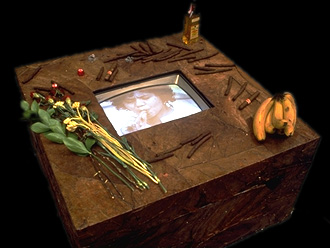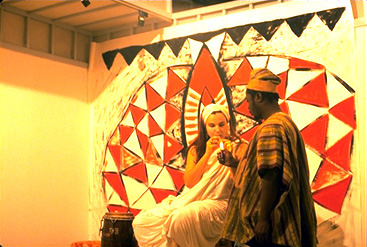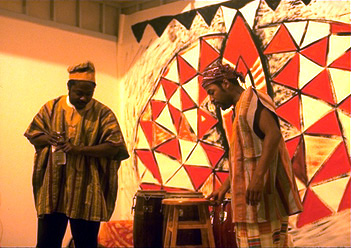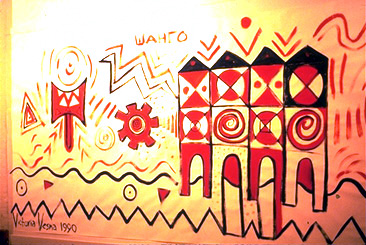 Beginnings
are always very difficult for me. Perhaps I was marked for this fate by way
I was born. My mother was in labor for two lays and two nights. To this day
she describes in vivid detail the horror of my birth. There was a knife next
to her bed; they had to wrestle it away from her. She wanted to kill herself....
Finally I came into the world, feet first.
Beginnings
are always very difficult for me. Perhaps I was marked for this fate by way
I was born. My mother was in labor for two lays and two nights. To this day
she describes in vivid detail the horror of my birth. There was a knife next
to her bed; they had to wrestle it away from her. She wanted to kill herself....
Finally I came into the world, feet first.
When I gave birth to
Angelica, it also took me two days and two nights of primal pain. I could not
deliver. Way past the deadline, I was weeks overdue. In the end the birth was
not at all natural; helped along by the doctors, it was anticlimactic. Angelica's
appearance, however, absolved all the guilt I had carried around for years;
I was overwhelmed with a beautiful feeling of relief.
Men in America give
out cigars to celebrate the birth of their sons. I participate in this peculiar
custom by presenting this cigar story to celebrate my daughter, born in the
midst of this project.
Whether smoked in a peace
pipe by the Indians or in cigarettes by Hollywood stars, tobacco is intertwined
with the history of this continent. Even now, in the midst of the anti-smoking
campaign, it is no less a preoccupation: nowhere in the world are people so
adamantly and passionately against smoking. From a pure ritual of the Indians,
smoking was transformed into a commercial, addictive, cancerous industry. Hopefully
one day we will again discover the ritual...
 Several
years ago I had to pass through a cigar factory regularly on the way to my workspace.
Seeing the women making cigars made me curious about tobacco, smoke and fire.
I am not a smoker and yet, as if drawn by a magnet, I went further and further
into the symbolism of the cigar and tobacco leaf. With this unlikely subject
to consume me, I got in touch with a memory deep inside each one of us: when
the first spark produced the first flame. I went far from my background in Yugoslavia,
to a culture entirely different, in Africa, only to discover this same memory.
Several
years ago I had to pass through a cigar factory regularly on the way to my workspace.
Seeing the women making cigars made me curious about tobacco, smoke and fire.
I am not a smoker and yet, as if drawn by a magnet, I went further and further
into the symbolism of the cigar and tobacco leaf. With this unlikely subject
to consume me, I got in touch with a memory deep inside each one of us: when
the first spark produced the first flame. I went far from my background in Yugoslavia,
to a culture entirely different, in Africa, only to discover this same memory.
The spirit of lightning
and fire is everywhere, and as this natural force traveled, it was colored by
the different cultures it touched, given a variety of names and forms by the
minds it inspired, the hearts it penetrated: the energy with which the World
began, with which it will end, the energy of Fire, the Creator and the
Destroyer.
 The
first memory I have of tobacco is from my childhood in Indonesia. I remember
rice fields, tea fields and tobacco fields. I remember men and women not only
smoking hand-rolled cigarettes, but chewing tobacco. Their teeth would rot from
it, and when they smiled, a bright Red stain flashed. Another strong memory
from this period surfaced many times as I delved into the tobacco smoking story
The
first memory I have of tobacco is from my childhood in Indonesia. I remember
rice fields, tea fields and tobacco fields. I remember men and women not only
smoking hand-rolled cigarettes, but chewing tobacco. Their teeth would rot from
it, and when they smiled, a bright Red stain flashed. Another strong memory
from this period surfaced many times as I delved into the tobacco smoking story
My parents took us to a
funeral rite in Bali. It was twilight. There were many dressed-up people, dancing
and feasting; it was a great celebration. When the funeral procession finally
emerged, everyone was so excited. A group of men came out carrying the corpse,
which was wrapped in a huge banana leaf and covered with lotus flowers. The
structure upon which the corpse was placed was built from bamboo sticks, and
to me it seemed endless in height. When they brought out his wife, the crowd
went into a frenzy. She was dressed in the finest embroidered silks, covered
head to toe in jewels and wore a gold crown on her head, with flowers all over.
She climbed onto a tall ladder and sat next to her late husband. At this point
my memory blurs. They proceeded to light the structure on fire. It became my
nightmare. Someone said that the bride goes to the heavenly abode with the husband.
My father assured me that this is not the case anymore; there is a law against
it. I don't know to this day what happened.
I had nightmares for years
after. Did she scream in the flame? Did she die with the man wrapped in the
banana leaf? Twenty years later, while traveling through India, I saw a TV show
about Sati, the practice of putting to death the bride of the dead man. Apparently,
to this day it goes on. In fact the subject of the show was a sixteen-year-old
bride who was put to death that year in a village. In Sati, a woman is drugged,
then a group of men come to the home and start dancing around her, chanting
a death song, and then they kill her. This is a way to ensure that the inheritance
stays in the husband's family and is not passed over to the wife. If somehow
the woman manages to escape this dreadful fate, she is doomed in the community
and may end up killing herself in despair or turning to prostitution to survive.
One of the images from this show that stuck in my mind was a rally of villagers
protesting the law which forbade the custom of bride burning. Behind the main
speaker was a picture of a beautiful woman enveloped in flames. The audience
was composed of angry chanting men. It sends a shiver through my spine.
Raised in an atheistic environment,
I've never been taught a religion. This made me free to enter temples, churches,
mosques and synagogues and marvel at the spiritual source in much the same way.
The theatrical quality of religious rituals moves me. I especially feel close
to the ancient nature religions, particularly Zoroastrianism, because there
the element of fire is central to worship. In Zoroastrianism, fire is believed
to be the son of God and is called on as a Warrior. The most sacred of fires,
the Bahram fire, is required in order to do battle with the spiritual demons
of darkness.
 Millennia
of millennia ago, my ancestors migrated from the Himalayas. This warrior tribe
walked for miles, making rest stops of a few days, then continuing on to look
for their new home. They needed a sign in order to settle down. The sacred fire
was carried in golden pots and was never allowed to die out. Not only was it
a source of spiritual strength, warmth and light, it was also a protection against
wild beasts at night. When they reached the river Danube, they were very impressed
and decided to rest awhile on this fertile soil. That very night a bolt of lightning
struck at the center of the river and a two-headed bird came out with a loud
thunderclap. At its stomach was a Red and blue spiral which revolved with great
speed and emanated tremendous heat. Then the bird turned into a puff of smoke
and disappeared. Since the tribe worshiped Perun, the God of Thunder, they knew
that this was the auspicious sign they were looking for, and made this land
their home. Somewhere in my genetic makeup, the memory of this story is encoded.
Millennia
of millennia ago, my ancestors migrated from the Himalayas. This warrior tribe
walked for miles, making rest stops of a few days, then continuing on to look
for their new home. They needed a sign in order to settle down. The sacred fire
was carried in golden pots and was never allowed to die out. Not only was it
a source of spiritual strength, warmth and light, it was also a protection against
wild beasts at night. When they reached the river Danube, they were very impressed
and decided to rest awhile on this fertile soil. That very night a bolt of lightning
struck at the center of the river and a two-headed bird came out with a loud
thunderclap. At its stomach was a Red and blue spiral which revolved with great
speed and emanated tremendous heat. Then the bird turned into a puff of smoke
and disappeared. Since the tribe worshiped Perun, the God of Thunder, they knew
that this was the auspicious sign they were looking for, and made this land
their home. Somewhere in my genetic makeup, the memory of this story is encoded.
 Beginnings
are always very difficult for me. Perhaps I was marked for this fate by way
I was born. My mother was in labor for two lays and two nights. To this day
she describes in vivid detail the horror of my birth. There was a knife next
to her bed; they had to wrestle it away from her. She wanted to kill herself....
Finally I came into the world, feet first.
Beginnings
are always very difficult for me. Perhaps I was marked for this fate by way
I was born. My mother was in labor for two lays and two nights. To this day
she describes in vivid detail the horror of my birth. There was a knife next
to her bed; they had to wrestle it away from her. She wanted to kill herself....
Finally I came into the world, feet first.
 Several
years ago I had to pass through a cigar factory regularly on the way to my workspace.
Seeing the women making cigars made me curious about tobacco, smoke and fire.
I am not a smoker and yet, as if drawn by a magnet, I went further and further
into the symbolism of the cigar and tobacco leaf. With this unlikely subject
to consume me, I got in touch with a memory deep inside each one of us: when
the first spark produced the first flame. I went far from my background in Yugoslavia,
to a culture entirely different, in Africa, only to discover this same memory.
Several
years ago I had to pass through a cigar factory regularly on the way to my workspace.
Seeing the women making cigars made me curious about tobacco, smoke and fire.
I am not a smoker and yet, as if drawn by a magnet, I went further and further
into the symbolism of the cigar and tobacco leaf. With this unlikely subject
to consume me, I got in touch with a memory deep inside each one of us: when
the first spark produced the first flame. I went far from my background in Yugoslavia,
to a culture entirely different, in Africa, only to discover this same memory. The
first memory I have of tobacco is from my childhood in Indonesia. I remember
rice fields, tea fields and tobacco fields. I remember men and women not only
smoking hand-rolled cigarettes, but chewing tobacco. Their teeth would rot from
it, and when they smiled, a bright Red stain flashed. Another strong memory
from this period surfaced many times as I delved into the tobacco smoking story
The
first memory I have of tobacco is from my childhood in Indonesia. I remember
rice fields, tea fields and tobacco fields. I remember men and women not only
smoking hand-rolled cigarettes, but chewing tobacco. Their teeth would rot from
it, and when they smiled, a bright Red stain flashed. Another strong memory
from this period surfaced many times as I delved into the tobacco smoking story Millennia
of millennia ago, my ancestors migrated from the Himalayas. This warrior tribe
walked for miles, making rest stops of a few days, then continuing on to look
for their new home. They needed a sign in order to settle down. The sacred fire
was carried in golden pots and was never allowed to die out. Not only was it
a source of spiritual strength, warmth and light, it was also a protection against
wild beasts at night. When they reached the river Danube, they were very impressed
and decided to rest awhile on this fertile soil. That very night a bolt of lightning
struck at the center of the river and a two-headed bird came out with a loud
thunderclap. At its stomach was a Red and blue spiral which revolved with great
speed and emanated tremendous heat. Then the bird turned into a puff of smoke
and disappeared. Since the tribe worshiped Perun, the God of Thunder, they knew
that this was the auspicious sign they were looking for, and made this land
their home. Somewhere in my genetic makeup, the memory of this story is encoded.
Millennia
of millennia ago, my ancestors migrated from the Himalayas. This warrior tribe
walked for miles, making rest stops of a few days, then continuing on to look
for their new home. They needed a sign in order to settle down. The sacred fire
was carried in golden pots and was never allowed to die out. Not only was it
a source of spiritual strength, warmth and light, it was also a protection against
wild beasts at night. When they reached the river Danube, they were very impressed
and decided to rest awhile on this fertile soil. That very night a bolt of lightning
struck at the center of the river and a two-headed bird came out with a loud
thunderclap. At its stomach was a Red and blue spiral which revolved with great
speed and emanated tremendous heat. Then the bird turned into a puff of smoke
and disappeared. Since the tribe worshiped Perun, the God of Thunder, they knew
that this was the auspicious sign they were looking for, and made this land
their home. Somewhere in my genetic makeup, the memory of this story is encoded.